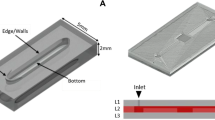Abstract
The microfluidic device needs multi-step fabrication, and this process relatively takes time because it requires meticulous treatment. This approach, using laser engraving, reduces the conventional mold fabrication step which is created by soft lithography in the cleanroom. For biomedical research purposes, a certain dimension of the microfluidic design needs to be achieved. Meanwhile, different material needs different variable setting in laser engraving. This article’s research objectives are seeking the optimum variable to achieve targeted dimension and investigating the influenced parameters lead to better understand the laser engraving fabrication process. The Poly (methyl methacrylate) (PMMA) sheets had been engraved to a particular dimension refers to the mold design that uses in the microfluidic device. The result showed that parameters meet the desired dimension found at values: 1000 for resolution, 95 for power, 500 for frequency, and 60 for speed. It can be noted that these adjusted parameters were performed for a single passage. Moreover, these influenced parameters also had been investigated to see their effect related to the engraving result. The result showed that the speed was the most significant parameter meanwhile the frequency has a stagnant value in the laser engraving process. This study also observed that higher resolution could smoother the rough surface. This study emerges the potential of laser engraving as rapid prototyping machinery for microfluidic technology.
Access this chapter
Tax calculation will be finalised at checkout
Purchases are for personal use only
Similar content being viewed by others

References
Zervantonakis IK, Kothapalli CR, Chung S, Sudo R, Kamm RD (2011) Microfluidic devices for studying heterotypic cell-cell interactions and tissue specimen cultures under controlled microenvironments. Biomicrofluidics 5(1)
Chung S, Sudo R, Vickerman V, Zervantonakis IK, Kamm RD (2010) Microfluidic platforms for studies of angiogenesis, cell migration, and cell-cell interactions: sixth international bio-fluid mechanics symposium and workshop March 28–30, 2008 Pasadena, California. Ann Biomed Eng 38(3):1164–1177
Barlocchi UMG, Villa FF (2012) Microfluidic system for real time PCR sample preparation. Lect Notes Electr Eng 109 LNEE:257–260
Caputo D et al (2014) Thermally actuated microfluidic system for polymerase chain reaction applications D. Lect Notes Electr Eng 268 LNEE:313–316
Lucia Giampetruzzi LF, Barca A, De Pascali C, Capone S, Verri T, Siciliano P (2019) Human organ-on-a-chip: around the intestine bends, pp 135–140
Emanuele Luigi Sciuto SC A Novel lab-on-disk system for pathogen nucleic acids analysis in infectious diseases, pp 135–140
Emanuele Luigi Sciuto SC (1997) Abstract: innovative lab-on-disk technology for rapid and integrated analysis of pathogen nucleic acids Emanuele, pp 1–398
Najeeb SP, Chavali M (2014) Nano-based PSA biosensors: an early detection technique of prostate cancer. J Biomimetics Biomater Biomed Eng 20:87–98
Chen CH et al (2013) Multiplexed protease activity assay for low-volume clinical samples using droplet-based microfluidics and its application to endometriosis. J Am Chem Soc 135(5):1645–1648
Ma L et al (2014) Gene-targeted microfluidic cultivation validated by isolation of a gut bacterium listed in human microbiome project’s most wanted taxa. Proc Natl Acad Sci USA 111(27):9768–9773
Shin Y et al (2012) Microfluidic assay for simultaneous culture of multiple cell types on surfaces or within hydrogels. Nat Protoc 7(7):1247–1259
Agalianos F, Patelis S, Kyratsis P, Maravelakis E, Vasarmidis E, Antoniadis A (2011) Industrial applications of laser engraving : influence of the process parameters on machined surface quality. Machine 1242–1245
Balchev I, Atanasov A, Lengerov A, Lazov L (1859) Investigation of the influence of the scanning speed and step in laser marking and engraving of aluminum. J Phys Conf Ser 1:2021
Bin Haron MNF, Romlay FRBM (2019) Parametric study of laser engraving process of AISI 304 stainless steel by utilizing fiber laser system. IOP Conf Ser Mater Sci Eng 469(1)
Imran HJ, Hubeatir KA, Al-Khafaji MM (2021) CO2 laser micro-engraving of PMMA complemented by Taguchi and ANOVA methods. J Phys Conf Ser 1795(1)
Sheean (2013) Microfabricated polyester conical microwells for cell culture applications. Lab Chip 23(1):1–7
Pérez-Rodríguez S, García-Aznar JM, Gonzalo-Asensio J (2021) Microfluidic devices for studying bacterial taxis, drug testing and biofilm formation. Microb Biotechnol
Xie L, Chen X, Yan H, Xie H, Lin Z (2020) Experimental research on the technical parameters of laser engraving. J Phys Conf Ser 1646(1)
Zhang W et al (2009) PMMA/PDMS valves and pumps for disposable microfluidics. Lab Chip 9(21):3088–3094
Romoli L, Tantussi G, Dini G (2011) Experimental approach to the laser machining of PMMA substrates for the fabrication of microfluidic devices. Opt Lasers Eng 49(3):419–427
Patko D, Mártonfalvi Z, Kovacs B, Vonderviszt F, Kellermayer M, Horvath R (2014) Microfluidic channels laser-cut in thin double-sided tapes: cost-effective biocompatible fluidics in minutes from design to final integration with optical biochips. Sens Actuators B Chem 196:352–356
Garcia CD, Gabriel EFM, Coltro WKT (2020) Fast and versatile fabrication of PMMA microchip electrophoretic devices by laser engraving. In: 18th international conference on miniaturized systems and chemical life science MicroTAS 2014, vol. 35, no 16, pp 1725–1727
da Costa ET, Santos MFS, Jiao H, do Lago CL, Gutz IGR, Garcia CD (2016) Fast production of microfluidic devices by CO2 laser engraving of wax-coated glass slides. Electrophoresis 37(12):1691–1695
Matellan C, Del Río Hernández AE (2018) Cost-effective rapid prototyping and assembly of poly(methyl methacrylate) microfluidic devices. Sci Rep 8(1):1–13
Trotec: What do the laser parameters mean? Optimal laser parameters for laser engraving and laser cutting for CO2 laser applications (2021). www.troteclaser.com. [Online]. Available: https://www.troteclaser.com/en-ms/knowledge/tips-for-laser-users/laser-parameters-definition/. Accessed on 26 Sept 2021
Author information
Authors and Affiliations
Corresponding author
Editor information
Editors and Affiliations
Rights and permissions
Copyright information
© 2022 The Author(s), under exclusive license to Springer Nature Singapore Pte Ltd.
About this paper
Cite this paper
Yusro, M. (2022). Emerging Potential on Laser Engraving Method in Fabricating Mold for Microfluidic Technology. In: Triwiyanto, T., Rizal, A., Caesarendra, W. (eds) Proceedings of the 2nd International Conference on Electronics, Biomedical Engineering, and Health Informatics. Lecture Notes in Electrical Engineering, vol 898. Springer, Singapore. https://doi.org/10.1007/978-981-19-1804-9_16
Download citation
DOI: https://doi.org/10.1007/978-981-19-1804-9_16
Published:
Publisher Name: Springer, Singapore
Print ISBN: 978-981-19-1803-2
Online ISBN: 978-981-19-1804-9
eBook Packages: EngineeringEngineering (R0)



